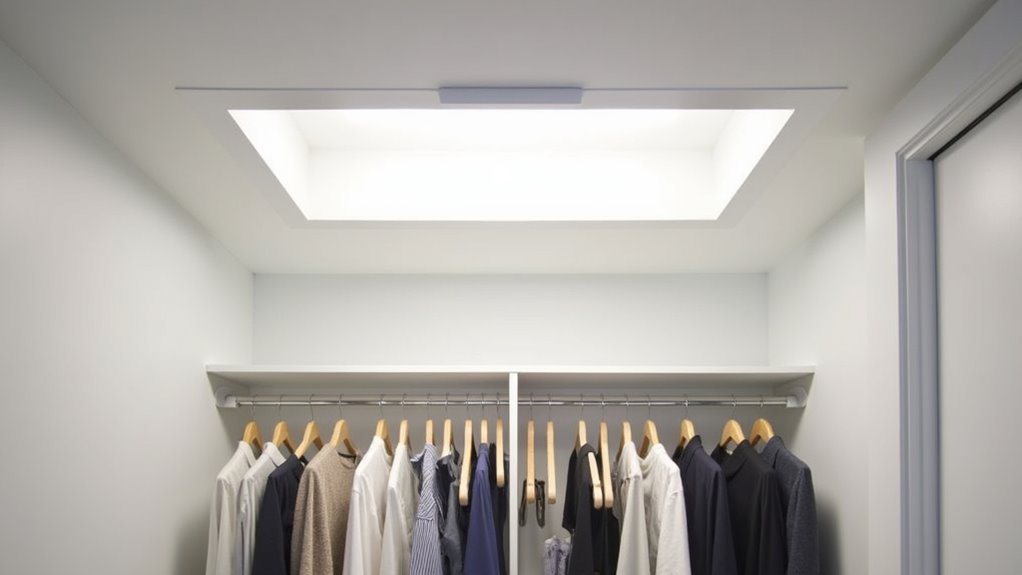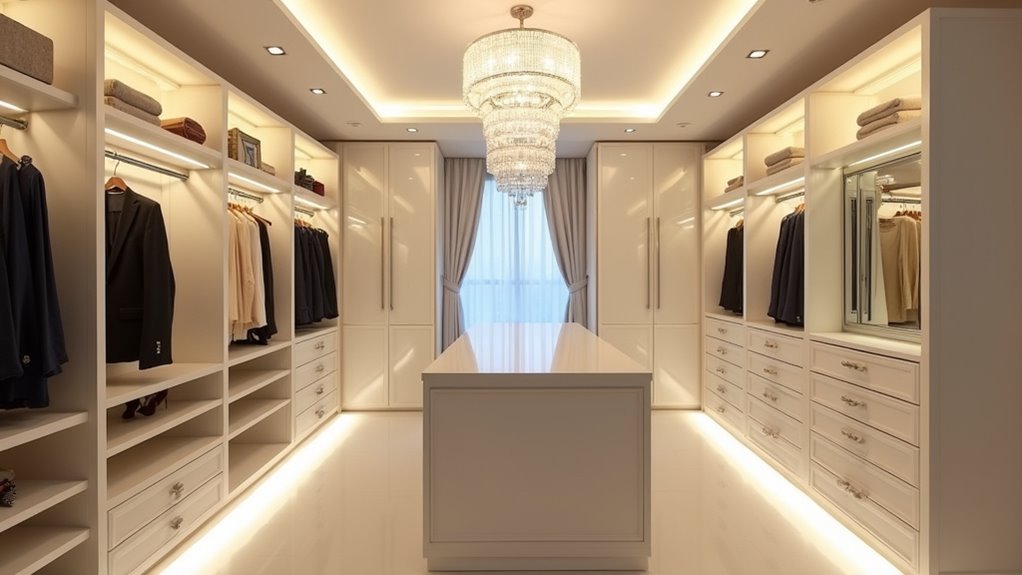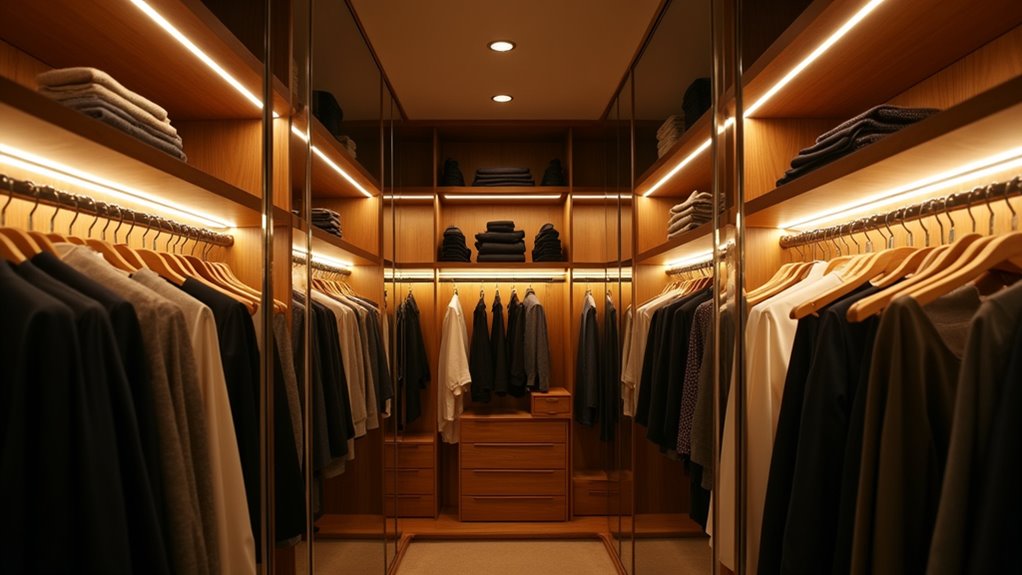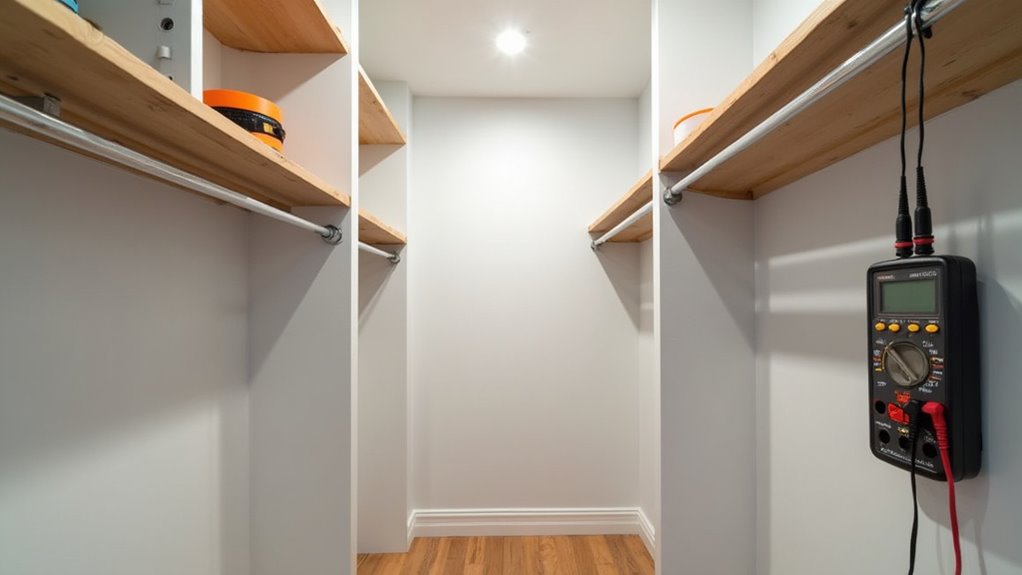Start by tracking your daily outfits and emotional connections through a style diary to understand your wardrobe needs. Create a versatile color scheme using one base, one complementary, and one accent color for your closet components. Maximize space with adjustable shelves, tiered hanging rods, and over-door organizers positioned at ideal heights. Incorporate smart technology like RFID tags and virtual wardrobe apps for enhanced organization. These foundational steps will unleash your closet’s full potential for personalization.
Assessing Your Personal Style and Storage Needs
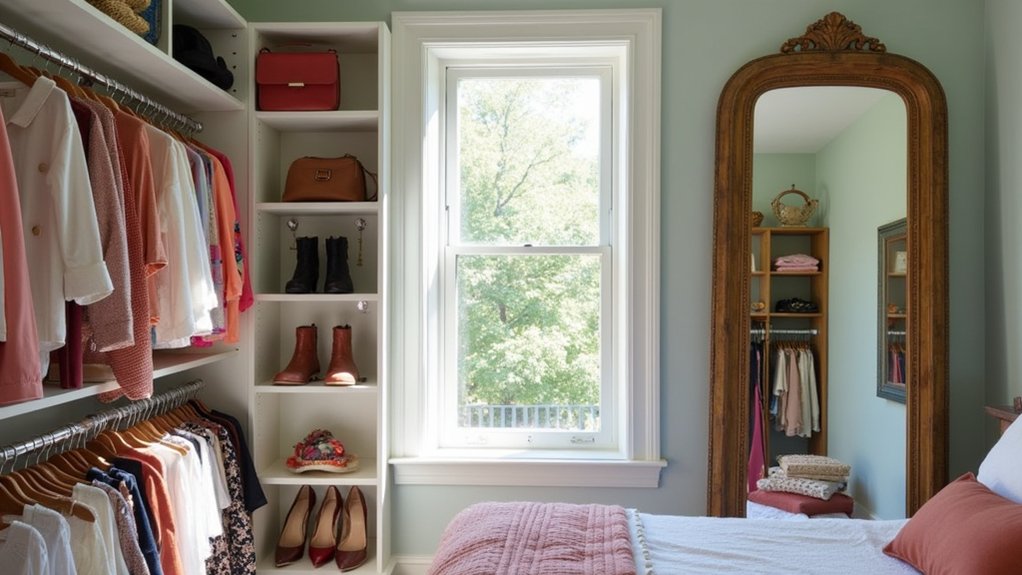
When beginning to customize your closet, understanding your personal style and storage requirements serves as the foundation for all future organization decisions. Start by tracking your daily outfits and emotional connections to clothing pieces through style diaries or photo logs. This process reveals your style evolution and helps identify which items truly represent your aesthetic vision. The 21 Question System can help you build a comprehensive style profile to guide your closet organization decisions. Consider limiting yourself to two colors per outfit to create a more cohesive and simplified wardrobe approach.
Conduct a thorough wardrobe evaluation by categorizing your clothes into essentials, seasonals, and statements. You’ll want your essentials to make up 50-60% of your closet. Use the three-word method to define your style attributes, then assess your storage needs based on wear frequency. Utilizing platforms like Pinterest and Instagram can provide additional inspiration for organizing your wardrobe effectively. Items you haven’t worn recently should be considered for donation or seasonal storage. This systematic approach guarantees your closet space efficiently accommodates pieces that match both your style preferences and practical needs.
Creating a Versatile Color Scheme
Three key principles guide the creation of a versatile color scheme for your closet: functionality, visual harmony, and adaptability. Your closet’s color palette should work hard for you while creating a space that’s both organized and inspiring. Neutral palettes serve as the perfect foundation for showcasing your wardrobe and accessories. Understanding the relationship between colors on the color wheel helps create balanced and harmonious combinations. The 60/30/10 distribution of colors ensures a professional and balanced appearance in your closet design.
Creating a functional and harmonious closet color scheme is about balancing organization with inspiration while maintaining flexibility for future changes.
- Start with a neutral base for your main storage components; this creates a flexible foundation that won’t overwhelm your space
- Apply the three-color rule to maintain color harmony while preventing visual chaos – choose one base color, one complementary shade, and one accent color
- Incorporate light colors on larger surfaces to create an open, airy feel, while using darker hues sparingly for sophistication
- Add personality through accent choices like colorful hardware, bins, or hangers that you can easily update as trends change
Smart Technology Integration for Modern Organization
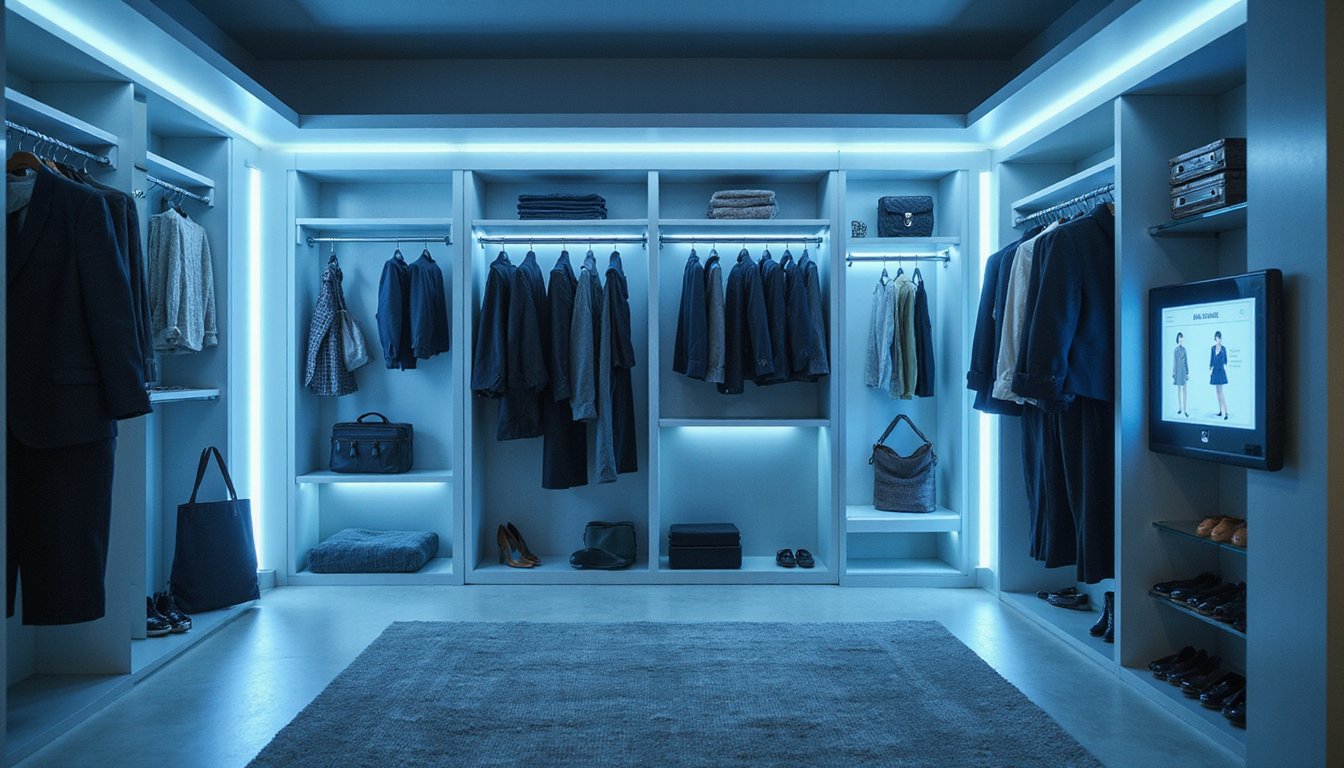
Modern closet organization has evolved beyond traditional storage solutions, embracing smart technology to revolutionize how you manage your wardrobe. Your smart closet can now feature RFID tags and automated tracking systems that monitor your clothing’s location and usage patterns, helping you identify which pieces you wear most frequently. Advanced humidity sensors maintain optimal conditions to protect delicate fabrics from damage. With enhanced protection, biometric access systems can secure your valuable fashion items while maintaining easy accessibility.
You’ll benefit from virtual wardrobe apps that integrate with your calendar, suggesting outfits based on weather and upcoming events. Install motorized racks and smart lighting systems to maximize space efficiency and guarantee accurate color selection during outfit planning. Consider adding adjustable storage modules that you can control via mobile apps, making it easy to reconfigure your space as needed. These tech integrations transform your closet into an intelligent system that streamlines your daily routine and enhances organization. Advanced motorized systems allow you to access hard-to-reach items with one-button control, eliminating the need for step stools or stretching.
Maximizing Space With Strategic Storage Solutions
Transform your closet’s untapped vertical space by installing adjustable shelves, tiered hanging rods, and over-the-door organizers that can increase storage capacity by up to 50%. You’ll maximize drawer functionality through customized dividers and modular storage units that adapt to your changing organizational needs. Position rods at optimal heights of 80.5 inches for women’s and 85.5 inches for men’s clothing to ensure comfortable access. By strategically placing hooks, bins, and specialized racks on walls and doors, you’ll create dedicated zones for accessories while keeping frequently used items within easy reach. Implementing a double hanging system allows you to effectively double your clothing storage space in the same footprint. Sliding door systems can maximize your available floor space while maintaining easy access to your belongings.
Vertical Storage Tricks
Making the most of vertical space stands as the cornerstone of efficient closet organization, especially in today’s smaller living spaces. By implementing strategic vertical storage solutions, you’ll transform your closet into a highly functional space that maximizes every inch from floor to ceiling. The demand for innovative storage solutions continues to rise as urban living spaces become increasingly compact.
- Install adjustable vertical shelving units that stretch to your ceiling, customizing shelf heights to accommodate everything from folded sweaters to tall boots
- Double your hanging capacity by adding a second rod below the first, creating dedicated zones for shirts above and pants below
- Utilize stackable storage bins on upper shelves for seasonal items and accessories, keeping them visible with clear containers or labels
- Incorporate vertical shoe racks that make use of tall, narrow spaces while keeping footwear organized and easily accessible
The Isa Custom Closet system provides adaptable shelving that eliminates wasted vertical space commonly found above hanging rods. Modern homeowners increasingly prefer to invest in sustainable materials for their vertical storage solutions, aligning with the growing eco-conscious market trends.
Smart Drawer Organization
While vertical storage maximizes your closet’s height, smart drawer organization serves as the foundation for keeping smaller items perfectly sorted and accessible. Start with adjustable drawer dividers to create customizable layouts that adapt to your changing needs. You’ll want to incorporate modular systems that let you stack and expand storage as your collection grows. Velvet-lined drawer inserts provide elegant protection for delicate accessories while maintaining an organized appearance.
Make the most of drawer space by using specialized trays for jewelry, belts, and accessories, while transparent storage bins guarantee you can quickly locate items. For clothing drawers, implement space-efficient folding techniques like file folding or rolling to maximize capacity. Consider stacking solutions with clear containers for smaller items, and organize compartments by category to prevent mixing. Remember to position frequently used items at the front of drawers for easy access.
Choosing Sustainable Materials and Finishes

When choosing materials for your custom closet, you’ll find excellent sustainable options in rapidly renewable bamboo, reclaimed wood, and eco-certified composites. You can further enhance your closet’s environmental impact by selecting water-based finishes and GREENGUARD-certified surface treatments that minimize chemical emissions. These sustainable choices don’t compromise on style or durability, as modern eco-friendly materials offer the same aesthetic variety and longevity as traditional options while reducing your carbon footprint.
Eco-Friendly Material Options
Today’s eco-conscious homeowners can transform their closets using sustainable materials that minimize environmental impact while maximizing style and functionality. When selecting eco-friendly textiles and sustainable finishes, consider these proven options:
- Choose TFL panels with recycled wood fibers or bamboo components, which offer durability while reducing forest impact. Look for CARB compliance and GREENGUARD certification to guarantee low emissions.
- Install storage solutions made from reclaimed wood or cork, providing unique character while preventing new resource extraction.
- Select water-based finishes and bio-based adhesives that maintain healthy indoor air quality by minimizing VOC emissions.
- Incorporate sustainable fabrics like organic cotton, TENCEL™, or REPREVE® recycled polyester for drawer liners and organizational accessories, supporting responsible manufacturing practices.
Design With Natural Finishes
Since natural finishes can transform your closet’s aesthetic and sustainability profile, selecting the right materials requires careful consideration of both form and function. Your choices in natural wood aesthetics range from classic hardwoods to eco-friendly bamboo, each offering unique characteristics for your space.
| Material Type | Durability Features | Finish Maintenance |
|---|---|---|
| Solid Wood | High-strength, classic grain | Regular oiling, occasional refinishing |
| Bamboo | Moisture-resistant, lightweight | Minimal upkeep, clear coating |
| Reclaimed Wood | Character-rich, sturdy | Light staining, preservation |
| Cherry/Maple | Heavy-load capacity | Periodic sealing |
| Walnut/Oak | Long-lasting, distinctive | UV protection, moisture control |
When selecting natural finishes, consider water-based polyurethane or low-VOC lacquers for protection while maintaining authenticity. These options guarantee your closet remains both beautiful and functional while supporting sustainable practices.
Incorporating Custom Features and Accessories
Transforming your closet into a highly functional space requires thoughtful integration of custom features and accessories that maximize storage while maintaining organization. When selecting custom shelving solutions and decorative storage accents, consider these essential elements:
Smart closet design balances form and function through strategic organization solutions that transform storage spaces into elegant, efficient systems.
- Install slide-out racks and pull-out organizers for ties, belts, and pants to prevent wrinkles and tangling while keeping items easily accessible
- Incorporate velveteen-lined jewelry drawers and divided compartments to protect valuable accessories and maintain an orderly arrangement
- Add LED-integrated glass-front cabinets and full-length mirrors to enhance visibility and create a boutique aesthetic
- Utilize vertical space with adjustable hanging rods, wardrobe lifts, and multi-purpose hooks for seasonal items and everyday essentials
These customizations will help you create a closet system that’s both efficient and visually appealing.
Planning Your DIY Installation Process
Before diving into your DIY closet installation, a well-planned approach will guarantee successful execution and prevent costly mistakes. Start by creating a detailed design layout, measuring your closet’s dimensions, and documenting all architectural features that might affect your project. You’ll need to carefully map out where studs are located and mark precise guidelines for shelf placement.
Next, focus on material selection, choosing appropriate lumber or closet system components that match your storage needs. Gather all necessary tools and supplies, including a level, stud finder, drill, and proper safety equipment. Pre-drill your support cleats and brackets to prevent splitting, and make sure you’ve got adequate wall anchors and hardware for secure mounting. Remember to prep your surfaces properly, addressing any needed repairs or paint touch-ups before beginning the actual installation.
Frequently Asked Questions
How Long Does Professional Closet Installation Typically Take?
Your professional closet installation timeline typically ranges from 1 to 3 days for standard systems, though walk-in closets may take up to 7 days. Installation factors like your closet’s size, complexity of features, and space preparation requirements will impact the duration. You’ll want to account for potential scheduling delays with installers, and be prepared for timeline adjustments if unexpected construction challenges arise during the process.
Can Closet Organizers Be Moved When Relocating to a New Home?
Yes, you can move most closet organizers during relocation. Modern systems, especially modular designs, are engineered for organizer flexibility and easy transport. You’ll need to carefully disassemble and label components, photograph your setup, and keep hardware organized. For successful closet relocation, measure your new space first to guarantee fit. While some built-in units require more effort to move, most systems can be safely dismantled and reinstalled in your new home.
What Maintenance Is Required for Smart Closet Systems?
To guarantee smart closet maintenance and system longevity, you’ll need to perform regular software updates and system resets. Keep sensors and interfaces clean with microfiber cloths, and lubricate moving parts like tracks and pulleys. You should monitor humidity levels, check wiring for wear, and respond to automated alerts about mechanical issues. Don’t forget to vacuum underneath components and schedule professional inspections every few years for structural integrity.
Are Built-In Safes Available for Integrated Closet Systems?
Yes, you’ll find numerous built-in safety options for integrated closet systems. You can choose from drawer-style, tilt-down, or panel-concealed safes that seamlessly blend with your closet’s design. For enhanced closet security, you’ll have access to features like biometric scanners, keypad entry, and smart home connectivity. Whether you’re planning a new installation or retrofitting an existing closet, you can select models that match your aesthetics while providing robust protection for valuables.
How Much Weight Can Adjustable Closet Rods and Shelves Support?
You’ll find that adjustable closet rods typically support 25-33 pounds when properly installed, while heavy-duty options can handle up to 264 pounds. Your rod’s weight limits depend largely on the materials used; steel offers greater strength than aluminum or plastic. For shelving, you can expect 15-40 pounds per linear foot for standard adjustable shelves, while heavy-duty wire options support 70-100 pounds per linear foot with correct bracket spacing.

